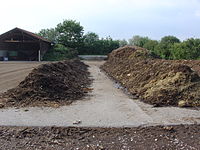
Photo from wikipedia
BackgroundBiofilters are soil-plant based passive stormwater treatment systems which demonstrate promising, although inconsistent, removal of faecal microorganisms. Antimicrobial-producing plants represent a safe, inexpensive yet under-researched biofilter design component that may… Click to show full abstract
BackgroundBiofilters are soil-plant based passive stormwater treatment systems which demonstrate promising, although inconsistent, removal of faecal microorganisms. Antimicrobial-producing plants represent a safe, inexpensive yet under-researched biofilter design component that may enhance treatment reliability. The mechanisms underlying plant-mediated microbial removal in biofilters have not been fully elucidated, particularly with respect to antimicrobial production. The aim of this study was therefore to inform biofilter vegetation selection guidelines for optimal pathogen treatment by conducting antimicrobial screening of biofilter-suitable plant species. This involved: (1) selecting native plants suitable for biofilters (17 species) in a Victorian context (southeast Australia); and (2) conducting antimicrobial susceptibility testing of selected plant methanolic extracts (≥ 5 biological replicates/species; 86 total) against reference stormwater faecal bacteria (Salmonella enterica subsp. enterica ser. Typhimurium, Enterococcus faecalis and Escherichia coli).ResultsThe present study represents the first report on the inhibitory activity of polar alcoholic extracts from multiple tested species. Extracts of plants in the Myrtaceae family, reputed for their production of antimicrobial oils, demonstrated significantly lower minimum inhibitory concentrations (MICs) than non-myrtaceous candidates (p < 0.0001). Melaleuca fulgens (median MIC: 8 mg/mL; range: [4–16 mg/mL]), Callistemon viminalis (16 mg/mL, [2–16 mg/mL]) and Leptospermum lanigerum (8 mg/mL, [4–16 mg/mL]) exhibited the strongest inhibitory activity against the selected bacteria (p < 0.05 compared to each tested non-myrtaceous candidate). In contrast, the Australian biofilter gold standard Carex appressa demonstrated eight-fold lower activity than the highest performer M. fulgens (64 mg/mL, [32–64 mg/mL]).ConclusionOur results suggest that myrtaceous plants, particularly M. fulgens, may be more effective than the current vegetation gold standard in mediating antibiosis and thus improving pathogen treatment within biofilters. Further investigation of these plants in biofilter contexts is recommended to refine biofilter vegetation selection guidelines.